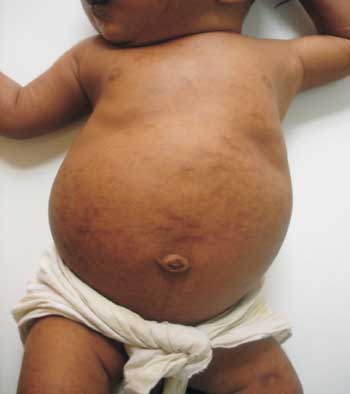|
|
|
Indian Pediatr 2013;50: 624 |
 |
Bronze Baby Syndrome
|
|
Sumit Kar, Atul Mohankar and Ajay Krishnan
Department of Dermatology, Venereology and Leprosy,
MGIMS, Sewagram, Wardha, Maharashtra 442012.
Email: [email protected] m
|
Bronze baby syndrome is the dark grey-brown pigmentation of
skin, mucous membrane and urine following phototherapy.
Hepatic dysfunction has to be there for this condition to be
present. We report a neonate with dark brown pigmentation of
skin. Lesions were spread over the abdomen (Fig. 1),
chest, back and both upper and lower limb after receiving
phototherapy for neonatal jaundice. It is assumed that
abnormal accumulation of photoisomer of bilirubin is the
cause of this condition. The second cause postulated is
abnormal hepatic function leading to copper-porpyhrin
complex which is photodestroyed leading to brown
pigmentation. The third explanation is accumulation of
biliverdin leading to pigmentation. It should be
differentiated from grey baby syndrome exclusively seen in
neonates and very young infants receiving high doses of
chloramphenicol. The infant is cyanosed, acidotic, has cold
peripheries and has the signs of all of marked hyponia, poor
feeding, vomiting, loose stools and a distended abdomen.
 |
|
Fig. 1 Brownish
pigmentation seen over the abdomen.
|
No treatment is required for bronze baby
syndrome as the pigmentation slowly disappears after
stopping phototherapy.
|
|
|
 |
|

